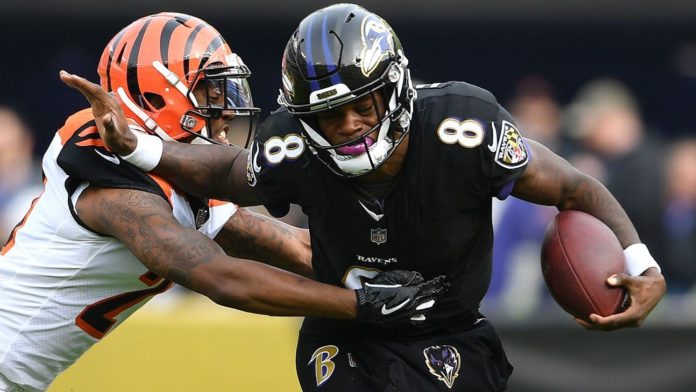Since John Harbaugh became the Baltimore Ravens coach in 2008, he has overseen many major changes, from switching franchise quarterbacks to revamping the defensive system.
One of the constants of the 12-year Harbaugh era has been how you earn your way onto the practice field in training camp — even in the virtual age, much to the chagrin of the players.
In wrapping up their remote offseason meetings last week, most of Baltimore’s players set up their phones on tripods and showed themselves running the league’s most revered and reviled conditioning test.
Rookies started joking on Twitter about how tired and exhausted they were after taking it. Reigning NFL MVP Lamar Jackson chimed in with a gif from “King of Queens” that showed comedian Kevin James dropping to his knees before falling face-first into the ground.
How Ravens players feel after the “sure death” test pic.twitter.com/2BCTxaM
— Lamar Jackson (@Lj_era8) June 17, 2020
In talking with current and former players, this conditioning test has remained the same, pushing the best athletes to the limit and causing many to fail.
Here’s the test: Players must run a total of 900 yards in six legs. Each set consists of 25 yards out and back three times. They must finish that heat of 150 yards under a designated time — 32 seconds for the offensive and defensive linemen, 29 seconds for the tight ends and linebackers and 27 seconds for the wide receivers, running backs and defensive backs. If you go over that time in any of the six legs, you flunk the test and have to take it over.
The break between each set is 64 seconds. By the end of it, players are sprawled on the ground, trying to catch their breath. Pro Bowl safety Earl Thomas acknowledged last year he nearly threw up after completing it.
“It is pure death,” said former running back Justin Forsett, who played for seven NFL teams. “It is the hardest conditioning test I had throughout my time in the NFL.”
Other teams have versions of this test. The New England Patriots have notoriously difficult timed sprints, and the New Orleans Saints have a CrossFit-inspired test.
What separates Baltimore is the change of direction. By dividing up the sprints into 25 yards — instead of 50 and 100 yards like other teams — players are cutting five times each leg.
You can’t slack off on any of the turns. If you don’t put your foot in the ground in making the cut, you lose time and typically flunk.
It’s around the fourth segment — about 500 yards in — when you feel the lactic acid building in your thighs and calves.
“My legs were gone by then,” said Fabian Washington, a cornerback for the Ravens from 2008 to 2010. “You can’t pick them up. It feels like you’re running in mud. It was definitely a shock.”
As legendary as this test has become in Ravens history, there’s no equally epic origin story. It wasn’t passed down from Bo Schembechler from Harbaugh’s teenage days at Michigan or started by Harbaugh’s father at Western Kentucky. Harbaugh actually can’t remember where it came from.
When he became the Ravens’ coach 12 years ago, he looked at tests that were the most comparable to football.
“There’s a baseline element to it of conditioning, a strength element to it,” Harbaugh said. “There’s also a coverage during a series when you have to go six or seven seconds hard. You get a little time off, and you’re right back at it going hard again in a 100 percent, explosive kind of a way.”
Before Harbaugh’s arrival in Baltimore, coach Brian Billick gauged the Ravens’ conditioning with a “beep test.” After the first beep, players ran 15 yards and back before the second one sounded. Each position group had a minimum it had to make (usually more than 40). This showed whether a player was in shape, but it didn’t challenge his endurance as much as the test later installed by Harbaugh.
In Harbaugh’s first offseason, Washington believes the players received a warning about the new test but he acknowledged he didn’t pay too much attention to it. He never had a problem passing a conditioning test before, and he had trained at the renowned IMG Academy.
Washington failed Harbaugh’s test in two of his three seasons with the Ravens.
“It’s literally the hardest crap ever,” he said.
Washington, a 2005 first-round pick by the Oakland Raiders, once ran the 40-yard dash in 4.29 seconds. But he soon learned that the key to passing the Ravens’ test wasn’t about speed.
In his first attempt, Washington flew through the first two legs in 23 seconds, which was four seconds faster than the time limit.
“That’s a terrible idea,” Washington said. “You should be coming in at 26. Save all your energy because on the back three. The back three is all determination. You’re going to need those couple extra seconds that you burn on the first few.”
He went five seconds over the time limit in the fifth segment and 15 seconds over in his final one.
Washington started what has become a long list of notable players who have failed. Every training camp, it’s nearly a lock that at least one starter isn’t going to be on the practice field for the first day because he didn’t pass the conditioning test.
Over the years, Haloti Ngata, Mike Wallace, Lardarius Webb, Terrence Cody, Orlando Brown Jr. and Jermaine Eluemunor have been among the players who flunked.
“It is pure death. It is the hardest conditioning test I had throughout my time in the NFL.”
Former Ravens running back Justin Forsett
Pro Bowl returner Jacoby Jones failed the test in 2013 after participating in “Dancing With The Stars” that offseason.
“I took it just about how like I took the ACT,” Jones said. “Eventually I passed.”
Until you pass, you are placed on the non-football injury list. That means you’re a spectator at practice.
“Every rep not taken is a rep missed,” Washington said. “You need to be on the field if you want to make the team. You have to hurry up and get in shape.”
There’s another deterrent, too.
“When you’re running it, you’re thinking in your head: Your punishment is you have to do this all over again,” Forsett said.
When Forsett played for the Ravens from 2014 to 2016, he made sure he attended the offseason conditioning program, which came with a huge perk. Players who regularly worked out at the Ravens’ facility during the spring didn’t have to take the full test. They had to run only a portion of test at the end of every week.
In Forsett’s final season with the Ravens, he chose to train in Florida and knew the test awaited him upon his return to Baltimore. He made sure he practiced it time and time again.
“It brings about anxiety,” Forsett said.
Starting offensive lineman Bradley Bozeman said the test challenges your mental strength just as much as your physicality. When players were allowed to take the test virtually last week, Bozeman went to a local high school and filmed himself running it. He didn’t want it hanging over his head all summer.
“If I’m going to study for a test, I want to take the test when I’m ready for the test,” Bozeman said.
Players get asked about the test almost every year. Their response: Take it and have someone time you.
Can any fan realistically pass it?
“No way,” Bozeman said. “Unless you’ve done training like this, I don’t see you really having a chance.”
Source : ESPN













